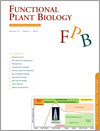
Functional Plant Biology
Volume 41 Number 4 2014
FP13189On the relationship between C and N fixation and amino acid synthesis in nodulated alfalfa (Medicago sativa)
The combination of double C13 and N15 labelling and subsequent compound-specific analysis in amino acids showed the imbalance observed between CO2 and N2 fixation in nodulated alfalfa plants. It provided a novel conclusion about the use and importance of pre-existing reserves in the production of new organic matter during growth.
FP13253Overexpression of AtbHLH112 suppresses lateral root emergence in Arabidopsis
Lateral root emergence is tightly regulated, although molecular components involved in this process are still largely unknown. This study showed that overexpression of a basic/helix-loop-helix (bHLH) transcription factor AtbHLH112 specifically suppresses lateral root emergence by decreasing the local auxin level and downregulating expression of cell-wall-remodelling (CWR) genes. Our results suggest that AtbHLH112 may represent a novel repressor of cell separation during lateral root emergence.
FP13227Induction of high-affinity NO3– uptake in grapevine roots is an active process correlated to the expression of specific members of the NRT2 and plasma membrane H+-ATPase gene families
Understanding the biochemical and molecular determinants of nitrogen nutrition in grapevine is important for the quality of production and environmental protection. The nitrate uptake mechanism was studied in this crop for the first time, focusing on the high-affinity component and the need for energy coupling, highlighting nitrate induction in grapevine. The involvement of the NRT2, NRT3 and plasma membrane H+-ATPase gene families in nitrate uptake by roots was evaluated.
FP13219Root hydraulics in salt-stressed wheat
Salinity is a globally increasing problem threatening agricultural production and affecting plant growth through an osmotic stress that affects root water uptake. This is a comprehensive analysis of root water uptake properties (hydraulic conductivity) in wheat (Triticum aestivum L.) in response to salinity. Salinity reduces the hydraulic conductivity of roots and appears to prevent developmental changes in root water uptake pathways from taking place as they occur in nonstressed plants.
FP13158Reliability of ion accumulation and growth components for selecting salt tolerant lines in large populations of rice
Advanced molecular techniques require phenotyping of large rice populations. In this study, our aim was to identify useful indicators for reliable selection of rice genotypes for productivity in saline soil with minimal time and cost. The measure of Na+ exclusion (leaf Na+ concentration) was validated as the most reliable trait for salt tolerance, as long as the plants were grown for at least 3 weeks and moved past the osmotic-stress dominated phase. The most sensitive growth components were tiller number plant–1 and shoot water content (water g g–1 dry weight), and these were correlated significantly with leaf Na+ and injury scores.
FP13241Photosynthetic performance and biochemical adjustments in two co-occurring Mediterranean evergreens, Quercus ilex and Arbutus unedo, differing in salt-exclusion ability
Plants inhabiting Mediterranean coastal areas display contrasting strategies to cope with a wide range of stresses. Also, Mediterranean areas display a high level of biodiversity. Here we explored strategies adopted by two co-occurring woody evergreens when suffering from an excess of soil salinity. Species-specific leaf life-span and drought-tolerance strategies are tightly related with salt-exclusion mechanisms, which, in turn, greatly impacts upon salt-induced metabolic adjustments.
FP13200Shoot branching in nutrient-limited Trifolium repens is primarily restricted by shortage of root-derived promoter signals
The productivity and persistence of white clover are both dependent on shoot branching, so the negative effect of P deficiency on branching has profound effects. Regulation of branching in P-limited plants was shown to be via root-supplied promoter signal rather than by inhibitory signals or P nutrition. For clover, and possibly other stoloniferous species, P-deficiency indirectly inhibits branching by down regulating root-supplied promoter signal and the strigolactone pathway plays a minor role.
FP13239Circadian oscillation and development-dependent expression of glycine-rich RNA binding proteins in tomato fruits
The circadian clock is the endogenous mechanism that adjusts physiology and metabolism to time of day. Glycine-rich RNA-binding proteins, which participate in the output signal of the circadian clock in source organs, exhibit circadian oscillations that depend on developmental and temperature signals in tomato fruit. Studies on the timing of the interactions and their effects on fruit growth and metabolism provide a molecular mechanism connecting oscillators with outputs in fruits.
FP13248Awn primordium to tipping is the most decisive developmental phase for spikelet survival in barley
Grain yield is closely associated with grain number in barley, and improved spikelet survival is therefore an important trait for increasing grain yield. We identified awn primordium to tipping as the most critical subphase related to spikelet abortion, regardless of growing conditions. Spikelet survival was highly genetically controlled and an in-depth analysis of this trait is a worthwhile target for increasing yield.
FP13248 Abstract | FP13248 Full Text | FP13248PDF (709 KB) | FP13248Supplementary Material (318 KB) Open Access Article
FP13132Differential physiological responses of different rice (Oryza sativa) cultivars to elevated night temperature during vegetative growth
Asymmetric warming causes long-term reduction of diurnal temperature range with strong negative effects on plant growth and yield. Twelve rice cultivars were sorted by their high night temperature (HNT) response and sensitivity specific differences in growth parameters but not respiration rate were reported, while respiration rate and carbon depletion were excluded as primary sources of HNT sensitivity. Knowledge on HNT tolerant rice will support breeding of cultivars for changed global climate conditions.



